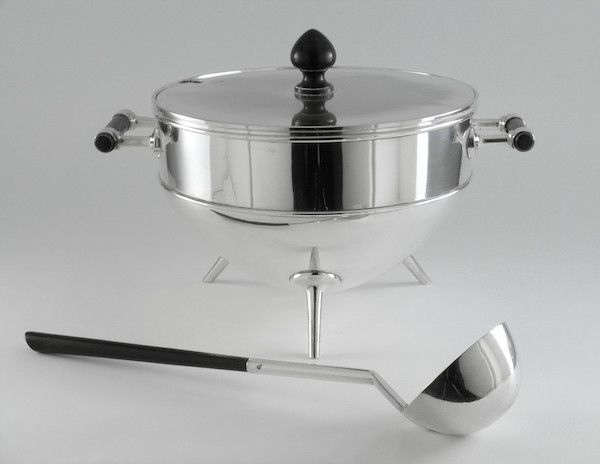Pae White wrestles in her work with the distinction between so-called high art and functional objects. At times she renders everyday objects in unexpected materials, like her larger-than-life marble popcorn sculptures, while also utilizing commercial materials, as with her chandeliers and mobiles made out of string, cut paper, and greeting cards. A Pasadena native, Pae White received her MFA from Art Center College of Design and now lives and works in Los Angeles.
For Artists on Art, LACMA’s online video series featuring contemporary artists speaking on objects of their choice from our permanent collection, White selected Christopher Dresser’s Soup Tureen and Ladle (c. 1877–78). Today, curator of modern art Carol S. Eliel speaks to White about her relationship to the object, a version of which she bought for herself many years ago at a thrift store (LACMA’s has ebonized wood fittings while her own has ivory).
You are an artist who also makes functional objects and really blurs, blends, and effaces the distinction between those two, so I’m curious what it is about this functional yet beautiful object yet sculpture that appeals to you. What made you choose this soup tureen and ladle to talk about?
I think this is an incredibly sexy object, and I think this object, designed by Christopher Dresser around 1880 in England, is a very practical idea of the soup tureen that has just slight moves that make that whole process incredibly rapturous and poetic. I’m one who believes that, depending on the quality of the glass or the lightness of something, you behave with an object differently if it has these special moments. In this case, the turn and thickness of the ladle deliver the soup in a very specific way. Everything has been carefully thought out: the termination points, the tapers—all are very well considered. And there is a hole [in the lid] that allows for the ladle to tuck in perfectly, so there's this beautiful consideration for the thickness of the ladle handle. I think all of this is worth noting: the fact that this is a pleasure in the hand, and all these points have a resolution that is extremely satisfying to actually hold, as well as this sort of seductive hardware.

Do you come to LACMA specifically for the museum’s decorative arts holdings?
I do; I think it’s important, and for me I find inspiration in these unexpected areas, like the micromosaics. I think what’s great about an encyclopedic collection is that you have these overlaps, and you have this kind of chance encounter that isn’t so programmed.
Since clearly you feel this sense of frustration when functional objects get removed from their functionality, how do you feel about your own functional objects that get acquired by museums and put in frames or Plexiglas cases?
Well, that’s a very good question, especially here, because LACMA owns one of my pieces, a sculpture with Vera textiles that are sandwiched and sealed between tempered glass, and then installed with a chair and an ashtray. The idea being that one would sit there and experience a textile, looking at it and smoking. It was taken off display because a shaft of sunlight fell on the textile [which museums typically show in very low lights levels]. For me this was part of the idea, that these textiles have a very ambiguous value. I paid 50 cents for them, and they’re infinitely replaceable; but the interior constraints of the institution [meant] the piece could not have sunlight on it. I like my work to be used, I encourage it if it’s appropriate. A lot of what I’m interested in does have sort of ambiguous value; when it enters into the realm of the museum, that seems to change. I like some interaction, but the objects that I design aren’t necessarily intended to be design objects. They’re always sculptures, they’re always artworks, they’re never necessarily just a design.
Is Christopher Dresser someone you follow?
No, because I would have had much more awareness when I bought my own tureen that it was important. I feel like at a certain point the object just is what it is, and with a lot of things that I collect, I want to keep the mystery. I don’t need to necessarily know all the deep story. But I know Dresser was an industrial designer, and there’s a certain modernity present in his work; and definitely a Japanese component that I’ve come across.
Did you get your tureen before you knew that LACMA has one? What was it like when you found out that LACMA has a piece just like yours?
I bought this at a thrift store because I felt sorry for it. I thought that the inside should have a glass casing that probably broke, and I thought, “Well, maybe one of these days, I’ll find the insert.” Then, I saw it at the V&A [Victoria & Albert Museum in London], and I think I saw one at the Metropolitan Museum [in New York], before I saw the one here at LACMA. Well, mine will just go right back to where I had it before (laughs)—with no A/C, in a wood cabinet.
The conversation was edited and condensed for clarity.



